We spent our first morning in Cambodia relaxing before taking on an afternoon cooking class. Scott went to fetch us some coffee, and who did he meet? Our Camry cab driver from Poipet, who recognized him, and was looking for a JOB! C’mon buddy!! You fed us to the tuk-tuk drivers (of which, by the way, there are millions everywhere asking you “TUK-TUK” every 5 meters)!!
Khmer Cooking Class
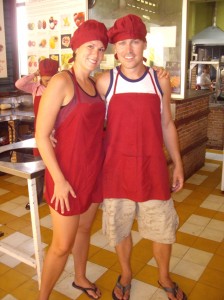
The Khmer Chefs
We did our cooking class at a place called “Le Tigre de Papier,” which is a restaurant that provides classes and all proceeds go to a cooking school for disenfranchised Cambodian women, Sala Bai. Our first stop was the local market, where our instructor, Nara, showed us all the local ingredients that are typically used in Khmer food. We saw everything from dead full plucked chickens, to fruit, to live eels. It was pretty intense.
We went back and started cooking. Scott and I had chosen mango salad, banana flower salad, a hot and sour soup and lotus root pork. Our cooking companion, Dawn (from England but who currently resides in Switzerland), had also chosen mango salad and chicken amok. We all got to make mango sticky rice for desert. We were given cute little chef outfits and began preparing the food. All of the utensils were wrapped in saran wrap to demonstrate their cleanliness, and we were told to wash our hands in a bowl with limes (there was no sink where we were). Preparations were pretty intense – lots of peeling and shredding and pounding of all the fresh herbs and spices. It was tough work!
While we were making the dessert, Nara asked us what is typically served for dessert in our country. We named a few, which she recognized, but she didn’t know carrot cake – it very much surprised her we would bake carrots into a cake! And also the use of zucchinis in baking…she didn’t even know what a zucchini was!
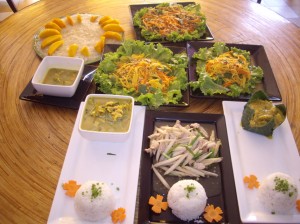
The finished product
After cooking for almost 2 hours, we got to reap the benefits of our cooking and were positively stuffed by the end of it. Khmer food is delicious – very similar to Thai, but without much use of chilis, so it is a lot milder.
We were pretty wiped after our cooking class and spent the rest of the day chilling out, walking around, and rubbing our full bellies. While walking around, we met Chrey – a 15 year old boy who had lost his leg from a landmine and was selling books to support himself and his very large family (six siblings) and single mother. We bought a pack of postcards and then decided on a book too. Unfortunately, a little girl saw us buying his cards and tried to sell us some of hers – we told her we didn’t need two packages and that we’d already told Chrey we would buy his. She started to cry, which made us feel pretty terrible and tugged on both Scott and I’s heart strings. We had to have a big talk after that about how we can’t save every child and that we have to be fair – if we’ve already committed to buying someone else’s item, we can’t change our minds just because they cry. Cambodia is a hard place to be because of this.
Angkor
You can’t come to Siem Reap and not see Angkor, so that’s where we headed on day two. We seriously debated over hiring a tuk-tuk driver to drive us around or rent bikes – it was a bit of a dilemma for us…get some exercise and get back into our passion of cycling, or support the local economy? In the end, we chose the bikes – the profit of the bike went to a community development program, we’d reduce our carbon footprint, enjoy the sites fully, and do what we love.
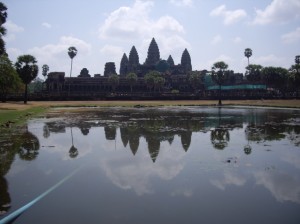
Angkor Wat
We got up early and headed to Angor Wat, the main temple, first thing. It was a 7 km ride from our hotel – not too bad. Our bikes were actually pretty decent too – cruiser bikes with baskets and pretty rusty…but not too shabby! Upon arriving, it was chaos. We were flagged down by some young girls and were told we could park our bikes for free. Hmmm…free…right. They seem to have a different meaning of “free” in Cambodia. So I say to the girl “I don’t think this is free…what is the deal here?” To which she (and about four other girls replied): “you have to buy my water when you come back.” Ahhh…gotcha. So off we went.
The whole area of Angkor is really interesting, and it’s one of the world’s biggest archaeological sites, with over a thousand temples in the area. It served as the main ruling city of the Khmer Empire from the 9th-13th centuries, until it was overtaken by the Thais (in fact Siem Reap literally means “Defeat of Siam,” and was named after the Cambodians retook the city later in history). Various kings throughout that period constructed temples for various reasons, some, like Angkor Wat, were built as the final resting place of the king who ordered it built, and some were tributes to family members. Today, the temples in the area range from piles of rubble to the magnificent Angkor Wat, the largest religious monument in the world.
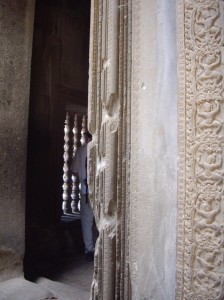
Bullet holes inside the temple from the civil wars
We decided to hire a guide, a fellow named Ra, for our tour of Angkor Wat. He took us around and explained the significance of EVERYTHING – he was very thorough. The ruins are in remarkably good condition – there’s a vast moat (750 m wide) surrounding the ruins, and some say that the moat helped protect the ruins from the jungle. Sadly though, sometimes people do much more damage than nature – we saw bullet holes and bomb markings, scars from the numerous civil wars that plagued the country until the death of Pol Pot in 1998. Some of the color in the stone had been removed as well, due to some careless (or ignorant) restoration work by some Indians at the turn of the century. Angkor Wat was originally a Hindu temple, but was converted to Buddhism with the ascent of one of the kings, Srindravarman in the 13th century. Some believe that there were some hard feelings from the Hindu restorers, so they didn’t take much care in the restoration and used acid on the stones, which bleached their color and removed some of the bas relief. There was also one area where their cleaning tools imprinted themselves into the ground from the acid on them – you can see an outline of a wrench. Furthermore, almost all of the statues and carvings are defaced or destroyed – very sad.
When we were done with Angkor Wat, we went back to get our bikes, and were accosted by about 10 girls claiming we had promised to buy their water. We had thought they were a part of a group! Not single operators! So we said no way, jose, we are only buying one water. One girl went to fetch it and came back demanding $5 for it…we had a laugh and said “dude, we know the price of water. We’ll give you $1. That’s more than double what it is worth.” Anyway, it was a pretty tricky situation to navigate.
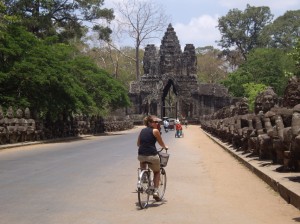
Biking through the gates of Angkor Thom
Next up was Angkor Thom – a city with many ruins within it and noted particularly for it’s beautiful square enclosure gate. We stopped outside for a photo opportunity, when a random elephant came charging through the entrance…and was headed straight for us. He came about half a meter away from me and my bike (now that would be an interesting story: Canadian girl trampled by run-away elephant in Angkor)…and this guy was NOT happy. He appeared to have ripped himself free from his holding device, and a very large chain and locking contraption were bonking against his body. Two Cambodian guys were running after him. We didn’t see any other elephants the rest of the day, but wherever they are being held captive, I don’t think they are too happy. 🙁
We stopped to visit Bayon, a temple full of face carvings that are actually a bit creepy. Next up was Terrace of Elephants, which was disappointing. I waited while Scott explored, shaking my head every two seconds to a new woman who was offering me a pineapple and a mango for $1. We then biked a few kilometres to Preah Khan and this is where the heat of the day really started to get to us. We were riding and hiking around in 37 degree weather in the SHADE…in the sun and with humidity was something ridiculous like 44. Insanity.
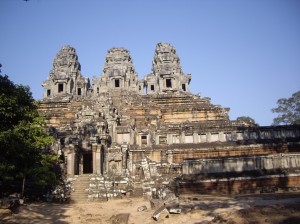
Preah Kahn
After walking around Preah Khan, we spent a few moments listening to a trio of musicians who consisted of men badly injured from various afflictions: one fellow was missing both legs and both arms and was blind. He was playing his drum by swinging his shoulder which was fitted with a prosthetic. We donated some money and moved along….only to be moved by a woman with two small babies who wanted to sell us a pineapple and a mango. We obliged, even though the pineapple was pre-cut and bathing in a giant chunk of ice/water that was definitely from a local source. (author’s note: we have not gotten sick from it, so I think we’re in the clear). We played with the babies while she cut our mango.
Upon exiting, about four ladies started yelling at us to buy some water…so being fair, we went to the one who we thought was first. This caused a bit of a scene – the other lady said, “but I watched your bikes!” This bugged me a bit – I had no recollection of this, and the bike was parked across the street, locked to a sign-post. Anyway, we ate some spring rolls and bought a few more litres of water and headed off for Ta Prohm.
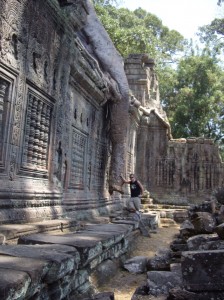
A tree trunk hangs over the walls of Ta Prohm
Ta Prohm was probably my favourite site (aside from Angkor Wat) – it was actually quite calm outside of this one (the accosting was minimal) and it was stunning. This is where they shot “Tomb Raider” – it is the site with all the crazy trees growing everywhere. Truly stunning. We took a moment to purchase some incense here and say a little Buddhist prayer.
Our last stop was Ta Keo, and Scott went in alone (because I didn’t think it actually was Ta Keo, I thought it was just a no-namer on the way). At the top, Scott met a local guy who was drawing pencil sketches of the temple and asked him to sit down. The local guy was very nice, and was enrolled in history at the university because his parents had told him that their country’s history was very important to learn. He was learning everything about the Angkor temples, for no other reason than to know it. And knew it he did – he was better than our Angkor Wat tour guide at explaining everything, where the stones came from, what the paintings and architecture meant, and all in extremely good English. Yet when asked about what he would do for a job, he had no idea. And this guy wasn’t young, he must have been 25 or so. Scott told him he should be a tour guide, but he seemed to think that was way beyond his capabilities. Just as Scott was leaving, he asked him for a bit of cash to support his studies, which Scott gave up given that he’d just been given a half-hour long history lesson. And then the guy said “do you have Canadian money? I’ve never seen that before.” Unfortunately, no, but he described it to him, as he was very interested in what it looked like.
We finally rode back to Angkor Wat for sunset and hung out on the rocks overlooking the moat. We seemed to be the only tourists doing this – we were surrounded by locals, most of whom were having a picnic dinner. As we were sitting a little boy came over and, although he didn’t speak much English, was having a fun time playing with us and showing off. His brother then came over, who was a bit older, and started talking to us. He asked me, ever so sadly, “can you give me a pencil, so I can go to school?” I nearly started crying at that moment. I didn’t have my purse, just a backpack with water, so I had no pen. I had nothing to give him.
We rode back into town at sunset through some harrowing traffic, and on very sore bums. Unfortunately, bike helmets do not exist here, so we were a bit naked…and I found it quite frightening. None of the intersections are controlled, so you just have to make a (very quick) judgement call and go for it. Things get particularly sticky when you have cars, motorbikes, tuk-tuks and other bikes all around you…and especially because a left turn here involves people cutting into the on-coming lane’s traffic and then working their way over. It was madness.
We made it back alive and hunkered down for a delicious Khmer food dinner and fell into bed with exhaustion. It was a very long and stimulating day for us…but Angkor is truly stunning.
Last Day in Siem Reap
If it is even possible, our last day in Siem Reap was by far the most heart wrenching of them all.
We kicked it off by visiting a place called “Seeing Hands,” where men who have been blinded (generally from gas or shrapnel from land mines) have been retrained as masseuses. We figured this would be an amazing experience – get a massage and help support the people in need.
When we arrived at the massage place, we were greeted by a few of the men – unfortunately, the language barrier was high, and visual gesturing on our part was not an option, so communication was minimal. We were taken to a very simple room and told to lie on our faces, and the massaging began. The type of massage was Shiatsu, so it involved lost of pressure point maneuvers which HURT. At first, the masseuse was a bit awkward as he figured out my body and where everything was, but by the end he had me totally mapped and it was awesome. A bit of drama came when it was time to pay though, as we didn’t have separate bills to give each fellow (it was $5 for the hour for each one) and this seemed to cause a problem, although we’re not quite sure because the language barrier was pretty steep. We also tried to give a tip, but we didn’t have any small bills, so it ended up being a lame tip and unequal for the guys. It was pretty awkward and taught us another valuable lesson: keep as many small bills as possible. This is easier said than done, as change is hard to come across around here and everyone wants us to pay with exact change.
The War Museum
After that, we headed for some lunch and decided to call Mr. Vannak – the tuk-tuk driver who saved us on our first day in Siem Reap. We had a few hours to kill before our night bus and thought we’d take in a local museum.
When he came to get us, he had the biggest smile plastered on his face and said “you called! Thank you so much for calling!” You could tell no one ever calls. But this man truly deserved it – he had the most soothing and sweet aura of nearly anyone I’d ever met. We said “of course – we said we’d call you if we needed a tuk-tuk!” We decided that we’d to go the War Museum, so that’s where he took us.
When we arrived at the War Musem, we were asked if we would like to hire a guide, “free” (but obviously for a donation at the end). Scott and I usually always do this because it’s a way better way to learn about the facts than trying to read very poorly translated signs. Our guide, Khom, was a 28-year old man who had lost his arm when he was 14. His story is heart breaking, like almost everyone in Cambodia, but he told it to us light heartedly and with a smile. I still can’t get over that – he had endured such trauma and horror and can almost make light of it. It’s unbelievable.
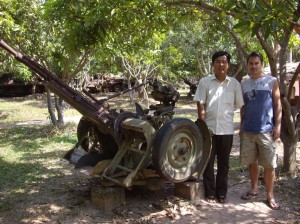
Khom and Scott with an artillery gun
Growing up, Khom came from a very poor family. They collected scrap metal from the fields which are sold to Vietnam, made into products, and sold back to Cambodia. Even though Cambodia is laced with three million mines today, and it is virtually unsafe to walk anywhere aside from a paved road, his family was so poor that the benefits outweighed the risks. When he was 14, his father tripped a mine and it killed his whole family in front of his eyes, and left him embedded with several pieces of shrapnel and took his arm. He was fortunate that he didn’t bleed out, as he said most land mine victims do, and was taken to the hospital. There, he was not given any anaesthesia (it is hard to come by here), and had his arm removed by a wire maneuvered by hand (there are also no machine saws here). He said it took them three hours to take off his arm – a pain that he cannot describe. He was shunned by his uncle for being an amputee and lived with monks and the Christian church until he was 18. It was very hard for him to find a job – there is zero support from the government, and the tourism industry refused him a job because he can’t carry the bags of tourists, or carry enough dishes at one time…things like that. So he now lives at the war museum with about 20 other men who are just like him. He says it is hard because they rely on the donations of tourists to survive and he is very sad because he doesn’t have a wife. He often gets very cold because of the metal that is still in him, and has to go back to the hospital every 3 years to have his arm re-sawed because the bone grows back. This is the horror of just one person in this country, and there are millions of stories just like his. Of 13 million people, four million were killed in the civil wars up to 1998, and today, one million live incompletely without an arm or a leg or an eye, etc. This is just one story.
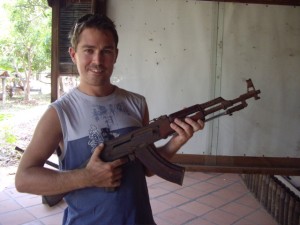
Scott never thought he'd hold an AK-47
Khom was an amazing tour guide and showed us all of the guns and machinery used for warfare in his country, from AK-47s to Tommy guns to hand grenades and land mines to tanks and artillery. It was deeply disturbing for me – I’ve never seen artillery used for violence before, let alone get to touch it. They still have authentic uniforms which are laden with holes and still have the blood stains on them. We even saw a real human bone, left in one of the tanks when they found it. In fact, the bone belonged to someone they knew. All the stuff at the museum had been collected from around Siem Reap, left right where it had last been abandoned when the owner was killed. It was horrific stuff, but important to see and hear, nonetheless.
If you’ve ever doubted it…when you’re sick of your job, your spouse, your kids, whatever…don’t ever forget how lucky you are. None of us has ever even come close to living the horror that these people have. We are so fortunate. Truly.
Definitely check out the photo gallery at the bottom for more crazy pictures of this place.
The Conversation with Mr. Vannak
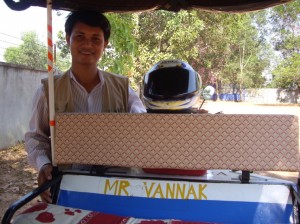
Our chatty tuk-tuk driver, Mr. Vannak
Scott and I left the War Museum with very heavy hearts (and a significantly lighter wallet after donating) and returned back to Mr. Vannak, who was all smiles. He was in the mood for chatting, so we spent about 30 minutes conversing, and it was lovely. He thanked us over and over again for calling him, and told us some more history about the Angkor temples we had seen the previous day. Then, he says to us “I have just one more question. May I?” And we say, of course. He asks “are you boyfriend and girlfriend?” (we say yes, because they don’t seem to understand the meaning of fiancée or engaged here – it’s a totally foreign idea to them.) We reply “yes.” And he giggles. I then ask, “how did you meet your wife?” And it comes out that it was an arranged marriage, that she is a distant cousin of his and was 10 years younger when they married. I figure that’s why he giggled – boyfriends and girlfriends don’t exist here, and they find the whole concept quite amusing. You mean, you get to CHOOSE who you want to marry? And you don’t have to marry right away? Mr. Vannak only met his wife once before their wedding ceremony. Such a different world.
And before I end, I think it’s important to acknowledge the women of Cambodia. We’ve only met and spoken to the physical victims of war, consisting mostly of men. This is because they have wounds we can SEE and are more open to talking. What about the little girl who was crying when we didn’t buy her postcard? I shudder to think about it. Before coming to Cambodia, both Scott and I read a book by Somaly Mam on the horrific sex trade that goes on here. Hundreds (if not thousands) of little girls are sold into prostitution, most often raped and beaten by local men. If that little girl doesn’t sell enough post cards, will she get sold to a brothel? Because we didn’t buy all the waters of all those 10 girls, will something happen to them? Alas, we do not know, but it is important to mention it.
The people of this country are beautiful and deserve so much more and I hope that maybe by telling a story of these few, we can help inform and mobilize our fellow Canadians and World family and friends. Princess Diana has left a lasting legacy in her determination to make Cambodia mine-free, for which the people here are so grateful. Even 10 years after her death, you can still see the white de-mining land rovers everywhere. I encourage every one of you to come visit this country and experience it for yourself and that together, we can educate and provide the tools that this country needs to become happy, healthy and whole.


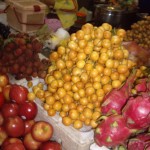
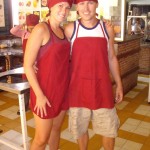
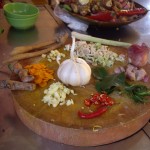
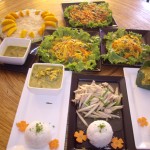
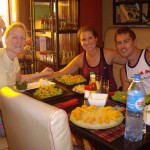
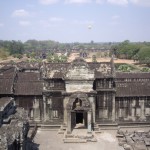
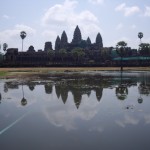
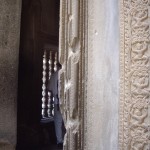
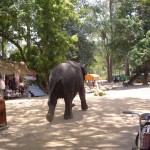
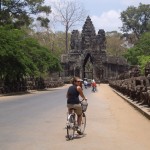
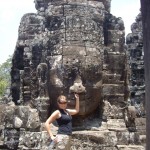
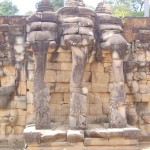
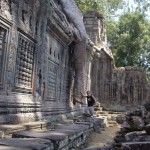
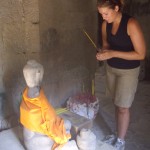
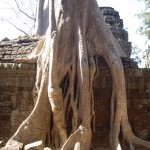
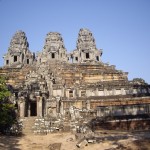
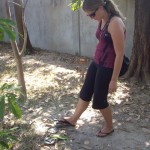
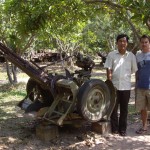

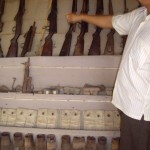
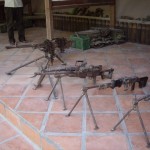
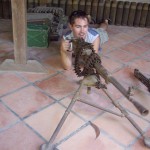
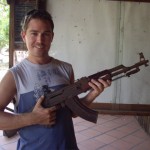
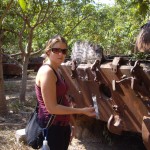
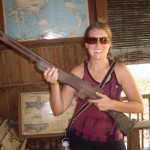
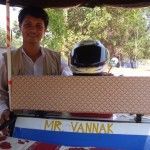
WOW! Cambodia looks like quite an amazing place. I can’t believe what happened to Khom. :'( So terrible. It really puts things into perspective doesn’t it?
What’s next after Cambodia? 🙂
Poor poor cows.
Kenna I told you before you left that parts of Cambodia would rip your heart out ! No pictures of the wall of human skulls we spoke of before you left? Anyway your account was very heart wrenching and I could feel myself tear up as I read this weeks edition to Lorna. Pol Pot should have been charged with Crimes against humanity but in some ways Cambodia is a lot like Tibet. Too small and poor for the 1st world to really care. Your account of the beggars reminded me a lot about our trips into Nicaragua. Young boys wanting to guide you through the market, smaller children selling packages of gum like their lives depend upon it. If my health allows it once I am officially retired 23 months and counting, Lorna and I would like to do some volunteer work either in Africa or Haiti come to mind. When you come home if you haven’t already seen it, get a copy of the Killing Fields. There is a book as well I believe and if there is you should read it first.
If anyone is going to Siem Reap and need a good, honest tuk-tuk, you should call Mr. Vannak… he’s like the sweetest guy we’ve ever met, unlike most of the drivers there. His # is 092848969.